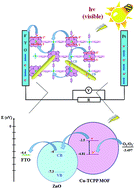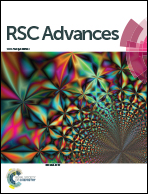Synthesis, characterization, and photocurrent generation of a new nanocomposite based Cu–TCPP MOF and ZnO nanorod
Abstract
A series of MOF/ZnO nanocomposites with different ZnO nanorod content were synthesized via a facile hydrothermal reaction. X-ray diffraction (XRD), UV-vis spectroscopy, field-emission scanning electron microscopy (FE-SEM), EDX, BET and FT-IR were employed to characterize the prepared samples. According to the UV-vis spectroscopy, the porphyrin center was filled with a Cu atom in Cu–TCPP. BET analysis shows that the surface area of Cu–TCPP MOF/ZnO nanorods composite was decreased compared to Cu–TCPP MOF. Therefore, ZnO nanorods covered the surface of the Cu–TCPP MOF crystals and distributed between the MOF nanosheets. Photocurrent measurements determined that MOF/ZnO nanocomposite with 15% of ZnO nanorod exhibited higher photoactivity under visible light irradiation. In the prepared nanocomposite, MOF sheets act as electron transport channels to efficiently separate the photogenerated charge carriers from ZnO nanorods. It is hoped that our current work could promote increased interest in designing the nanocomposites of one-dimensional semiconductor and two-dimensional MOFs for different photoassisted applications.


 Please wait while we load your content...
Please wait while we load your content...